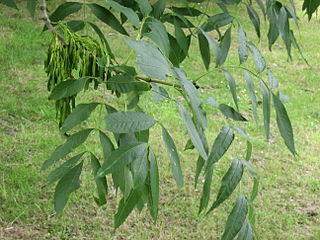
Fraxinus quadrangulata, the blue ash, is a species of ash native primarily to the Midwestern United States from Oklahoma to Michigan, as well as the Bluegrass region of Kentucky and the Nashville Basin region of Tennessee. Isolated populations exist in Alabama, Southern Ontario, and small sections of the Appalachian Mountains. It is typically found over calcareous substrates such as limestone, growing on limestone slopes and in moist valley soils, at elevations of 120–600 m.

Lee County is a county located in the U.S. state of Kentucky. As of the 2010 census, the population was 7,719. Its county seat is Beattyville. The county was formed in 1870 during the Reconstruction era from parts of Breathitt, Estill, Owsley and Wolfe counties. The county was named for Confederate general Robert E. Lee, which probably indicated the politics of the time, although the area of Kentucky where Lee County is located was a pro-union region of Kentucky

Fulton County is the westernmost county in the U.S. state of Kentucky, with the Mississippi River forming its western boundary. As of the 2010 census, the population was 6,813. Its county seat is Hickman. The county was formed in 1845 from Hickman County, Kentucky and named for Robert Fulton, the inventor of the steamboat.

Blue Ash is a city in Hamilton County, Ohio, United States, and is an inner suburb of Cincinnati, which is located to the south. The population was 12,114 at the 2010 census.

Leadbeater's possum is a critically endangered possum largely restricted to small pockets of alpine ash, mountain ash, and snow gum forests in the Central Highlands of Victoria, Australia, north-east of Melbourne. It is primitive, relict, and non-gliding, and, as the only species in the petaurid genus Gymnobelideus, represents an ancestral form. Formerly, Leadbeater's possums were moderately common within the very small areas they inhabited; their requirement for year-round food supplies and tree-holes to take refuge in during the day restricts them to mixed-age wet sclerophyll forest with a dense mid-story of Acacia. The species was named in 1867 after John Leadbeater, the then taxidermist at the Museum Victoria. They also go by the common name of fairy possum. On 2 March 1971, the State of Victoria made the Leadbeater's possum its faunal emblem.

Fraxinus excelsior, known as the ash, or European ash or common ash to distinguish it from other types of ash, is a flowering plant species in the olive family Oleaceae. It is native throughout mainland Europe east to the Caucasus and Alborz mountains, and the British Isles which determine its western boundary. The northernmost location is in the Trondheimsfjord region of Norway. The species is widely cultivated and reportedly naturalised in New Zealand and in scattered locales in the United States and Canada.

Abraham Lincoln Birthplace National Historical Park preserves two separate farm sites in LaRue County, Kentucky where Abraham Lincoln was born and lived early in his childhood. He was born at the Sinking Spring site south of Hodgenville and remained there until the family moved to the Knob Creek Farm northeast of Hodgenville when he was 2 years old, living there until he was 7 years old. The Sinking Spring site is the location of the park visitor center.

Kingdom Come State Park is a part of Kentucky's state park system in Harlan County atop Pine Mountain near the city of Cumberland. It was named after the 1903 best-selling novel The Little Shepherd of Kingdom Come by native Kentuckian John Fox, Jr. Features of the park include Raven Rock, Log Rock, and a 3.5-acre (1.4 ha) mountain lake. The section of the park is also a legally dedicated state nature preserve by the Office of Kentucky Nature Preserves.
Interstate 75 (I-75) runs from near Williamsburg to Covington by way of Lexington in the U.S. state of Kentucky. I-75 enters the Cumberland Plateau region from Tennessee, then descends into the Bluegrass region through the Pottsville Escarpment before crossing the Ohio River into Ohio. I-75 follows along the U.S. Route 25 corridor for the entire length of Kentucky.

Magoffin County Pioneer Village and Museum is museum in downtown Salyersville, Kentucky that exhibits a collection of reconstructed log buildings from, mostly, the eastern region of Kentucky. The Magoffin County Historical Society maintains a Library and Archives Center with a collection of genealogical and historical material at the site.
Celtic Ash (1957–1978) was an English-bred Thoroughbred racehorse raised in Ireland who is best known for winning the 1960 Belmont Stakes.

The Samuel May House is a Federal style residence located at 690 North Lake Drive in Prestonsburg, Kentucky. It built in 1817 by Samuel May, a Kentucky state representative (1832–1834) and a Kentucky state senator (1835–1838) from Floyd County. It now serves as the Samuel May House Living History Museum.

Golden Ash is an unincorporated community in Harlan County, Kentucky, United States.

White Ash is an unincorporated community and Coal town in Lee County, Kentucky, United States.












